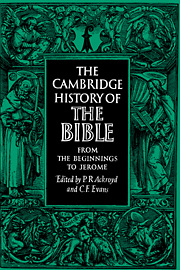Crossref Citations
This Book has been
cited by the following publications. This list is generated based on data provided by Crossref.
Andriolo, Karin R.
1981.
Myth and History: A General Model and Its Application to the Bible.
American Anthropologist,
Vol. 83,
Issue. 2,
p.
261.
Black, C. Clifton
1985.
Unity and Diversity in Luther's Biblical Exegesis: Psalm 51 As a Test-Case.
Scottish Journal of Theology,
Vol. 38,
Issue. 3,
p.
325.
Neusner, Jacob
1986.
Toward a theory of comparison.
Religion,
Vol. 16,
Issue. 3,
p.
269.
Epp, Eldon Jay
1989.
New Testament Textual Criticism Past, Present, and Future: Reflections on the Alands'Text of the New Testament.
Harvard Theological Review,
Vol. 82,
Issue. 2,
p.
213.
Mitchell, T. C.
1992.
The Cambridge Ancient History.
p.
410.
Mitchell, T. C.
1992.
The Cambridge Ancient History.
p.
322.
Boardman, John
Edwards, I. E. S.
Sollberger, E.
and
Hammond, N. G. L.
1992.
The Cambridge Ancient History.
Mitchell, T. C.
1992.
The Cambridge Ancient History.
p.
371.
Algra, Keimpe
Barnes, Jonathan
Mansfeld, Jaap
and
Schofield, Malcolm
1999.
The Cambridge History of Hellenistic Philosophy.
Wallace, David
1999.
The Cambridge History of Medieval English Literature.
Garber, Daniel
and
Ayers, Michael
2000.
The Cambridge History of Seventeenth-Century Philosophy.
Garber, Daniel
and
Ayers, Michael
2000.
The Cambridge History of Seventeenth-century Philosophy.
Ghosh, Kantik
2001.
The Wycliffite Heresy.
2008.
Psalms Through the Centuries.
p.
322.
McMullin, Ernan
2010.
Creation and the God of Abraham.
p.
11.
Victor, Benjamin
2011.
Une Bible portative du XIIIe siècle dans les collections de l’UQAM1.
Memini,
p.
23.
Zimmermann, Jens
2015.
A Companion to Hermeneutics.
p.
212.
Stoker, Hendrik G.
and
Derengowski, Paul
2017.
A discussion about the version of the Bible available to Muhammad.
In die Skriflig/In Luce Verbi,
Vol. 51,
Issue. 2,
Skarsaune, Oskar
2017.
The Early Christian World.
p.
647.
Wansbrough, Henry
2019.
The Biblical World.
p.
413.



